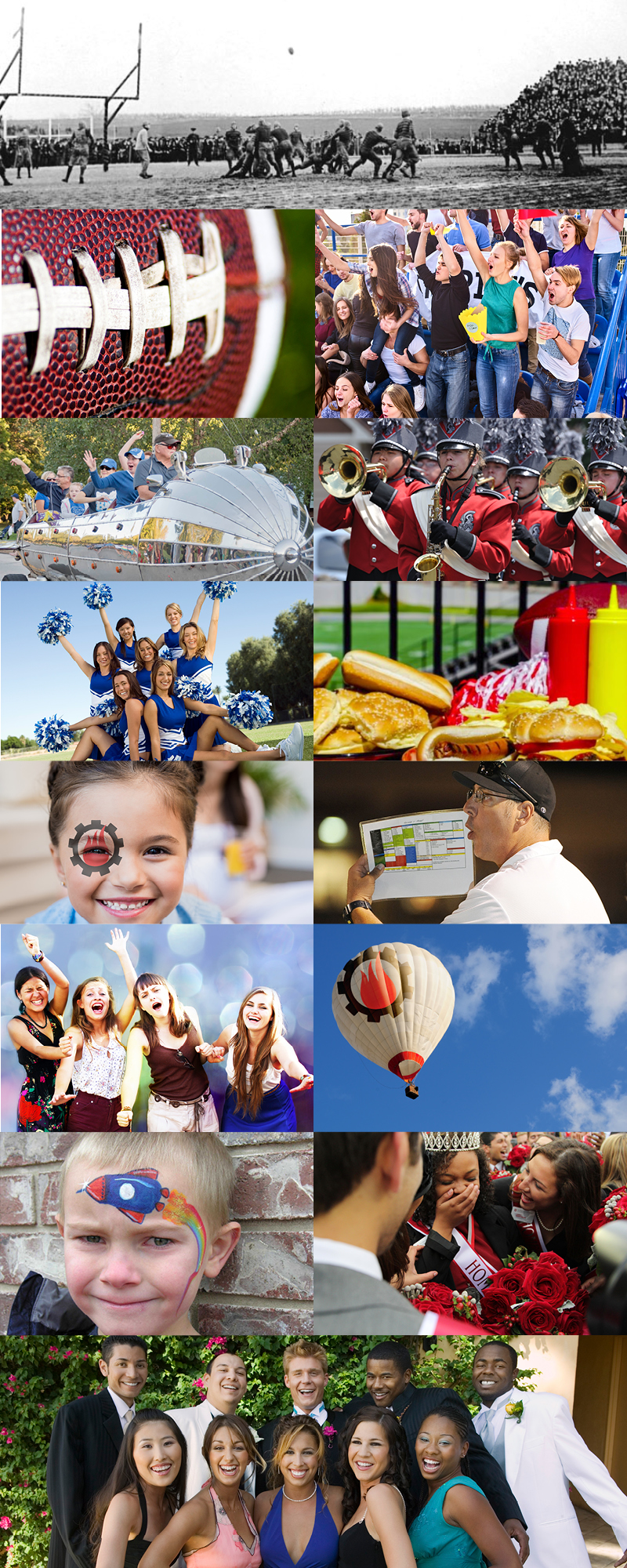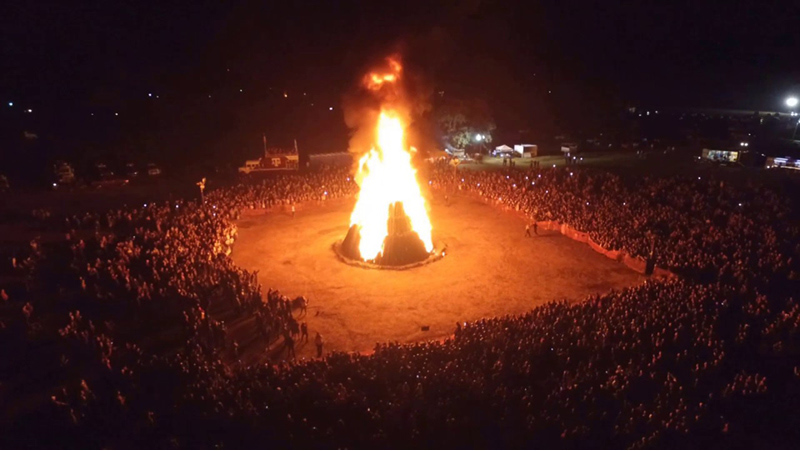Homecoming

(top) If you were at the first official Homecoming football game watching the Kansas vs. Missouri rivalry, besides being 117 years old, you saw it end in a 3-3 tie. Look! There’s the tying kick in the air. That kicked-off (pun intended) what was to become “Homecoming Week” with all of the fun events at colleges and high schools all across America.
One of my favorite events in the small town I live in is homecoming weekend – this year scheduled for tonight. It takes me back to memories of when the girls and Jackie would march in the parade. Where we live, homecoming includes a parade down the center of town – and it seems like everyone comes out, including the police dept, fire dept., HS marching band and cheerleaders, scouts, dignitaries, and numerous volunteer organizations. Participants in the parade have a tradition of tossing candy to the kids and adults lining the streets. On more than one occasion I have had the opportunity to be one of those folks throwing the candy. It’s amazing how far you can throw a Tootsie Roll or Jolly Rancher especially at people you know! Our service department has the PIA (Pain in the @%$) Job of cleaning up afterwards. Floats are handmade and include some really fun ideas. I hope you can attend the homecoming events in your town – here’s some fun trivia I came across in Wikipedia – Enjoy!
- Homecoming is an annual tradition in the United States. People, towns, high schools, and colleges come together, usually in late September or early October, to welcome back alumni and former residents. It is built around a central event, such as a banquet or dance and, most often, a game of football, or, on occasion, basketball, ice hockey, or soccer.
- When celebrated by schools, the activities vary widely. They usually consist of a football game played on a school’s home football field, activities for students and alumni, a parade featuring the school’s choir, marching band, and sports teams, and the coronation of a homecoming queen (and at many schools, a homecoming king and queen). A dance often follows the game or the day following the game. The game itself, whether it be football or another sport, will typically feature the home team playing a considerably weaker opponent to be an “easy win” and thus weaker schools will sometimes play lower division schools.
- The origin of homecoming dates back to the 1911 Kansas vs. Missouri football game, one of several claimed to be the first college football homecoming game. Of course, many schools including Baylor, Southwestern, Illinois, and Missouri have made claims that they held the first modern homecoming. The NCAA, Trivial Pursuit, Jeopardy!, and references from the American TV drama NCIS give the title to the University of Missouri’s 1911 football game during which alumni were encouraged to attend.
- In 1891, the Missouri Tigers first faced off against the Kansas Jayhawks in the first installment of the Border War, which was also the oldest college football rivalry west of the Mississippi River. The intense rivalry originally took place at neutral sites, usually in Kansas City, Missouri, until a new conference regulation was announced that required intercollegiate football games to be played on collegiate campuses. To renew excitement in the rivalry, ensure adequate attendance at the new location, and celebrate the first meeting of the two teams on the Mizzou campus, Mizzou Athletic Director Chester Brewer invited all alumni to “come home” for the game in 1911. Along with the football game, the celebration included a parade and spirit rally with bonfire. The event was a success, with nearly 10,000 alumni coming home to take part in the celebration and watch the Tigers and Jayhawks play to a scintillating 3–3 tie.
- Baylor’s homecoming history dates back to November 1909 and included a parade, reunion parties, and an afternoon football game (the final game of the 1909 season), a tradition that continued and celebrated its 100th anniversary in 2009.
- The event usually includes a homecoming court, a representative group of students that, in a coeducational institution, consists of a king and queen, and possibly prince(s) and princess(es). In a single-sex institution, the homecoming court will usually consist of only a king and a prince (for an all-male school) or a queen and a princess (for an all-female school), although some schools often choose to join with single-gender schools of the other gender to elect the homecoming court jointly. Generally, the king and queen are students completing their final years of study at their school (also called “seniors”), while the prince and princess are underclassmen, often with a prince/princess for each grade.
- Many homecoming celebrations include a parade. Students often select the grand marshal based on a history of service and support to the school and community. The parade includes the school’s marching band and different school organizations’ floats created by the classes and organizations and most of the sports get a chance to be in the parade. Every class is expected to prepare a float which corresponds with the homecoming theme or related theme of school spirit as assign by school administrators. In addition, the homecoming court takes part in the parade, often riding together in one or more convertibles as part of the parade. Community civic organizations and businesses, area fire departments, and alumni groups often participate as well. The parade is often part of a series of activities scheduled for that specific day, which can also include a pep rally, bonfire, snake dance, and other activities for students and alumni.
- At most major colleges and universities, the football game and preceding tailgate party are the most widely recognized and heavily attended events of the week. Alumni gather from all around the world to return to their alma mater, reconnect with one another, and take part in the festivities. Students, alumni, businesses, and members of the community set up tents in parking lots, fields, and streets near the stadium to cook food, play games, socialize, and even enjoy live music in many instances. These celebrations often last straight through the game for those who do not have tickets but still come to take part in the socializing and excitement of the homecoming atmosphere. Most tents even include television or radio feeds of the game for those without tickets.
- Many schools hold a rally during homecoming week, often one or more nights before the game. The events vary, but may include skits, games, introduction of the homecoming court (and coronation of the king and queen if that is the school’s tradition), and comments from the football players or coach about the upcoming game.
 Some homecoming bonfires are better than other homecoming bonfires. This 2016 Texas A&M, Aggie Student Homecoming Bonfire is some homecoming bonfire.
Some homecoming bonfires are better than other homecoming bonfires. This 2016 Texas A&M, Aggie Student Homecoming Bonfire is some homecoming bonfire.
- At some schools, the homecoming rally ends with a bonfire (in which old wood structures, the rival school’s memorabilia and other items are burned in a controlled fire.) Students are encouraged to come together, share in songs and cheering for the teams. Many schools include the marching band for music and fun.
- The alumni band consists of former college and university band members who return for homecoming to perform with the current marching band (usually made up from recent graduates to members who graduated years or decades before) either during halftime as a full band or a featured section, e.g. the trumpet section or the tubas and drumline squads, as well as performing with the current band during the post-game concert.
- High schools in the south of the United States, especially in Texas, often have a tradition of the girls wearing “mums” and boys wearing “garters” to the Homecoming football game. Mums usually consist of artificial chrysanthemums (real chrysanthemums were originally used) surrounded by decorated floor-length ribbon and little trinkets. The tradition is that the boys create a personalized mum in their school colors, making white and silver for seniors only, for their date. Girls make garters for their date which are similar to mums but shorter and worn on the boy’s arm. The size of the mums and garters tend to grow in proportion to the grade that the receiver is in. Depending on the school, mums can get quite competitive, expensive, and drastically bigger than they previously were intended to be. Different items are also placed on mums than there previously were, such as LEDs, bubble containers, cow bells, feather boas, stuffed animals of all sizes, etc. The tradition is to make the mum and garter after the couple is asked to homecoming, and exchange them on the night of the homecoming game and wear it throughout tailgating and the game. Couples often take group pictures with their mums and garters the evening of or the evening before the homecoming game to showcase them.
- The homecoming dance—usually the culminating event of the week (for high schools)—is a formal or informal event, either at the school or an off-campus location. The venue is decorated, and either a disc jockey or band is hired to play music. In many ways, it is a fall prom. Homecoming dances could be informal as well just like standard school dances. At high schools, the homecoming dances are sometimes held in the high school gymnasium or outside in a large field. Homecoming dance attire is less formal than prom.



Leave a Reply
Want to join the discussion?Feel free to contribute!